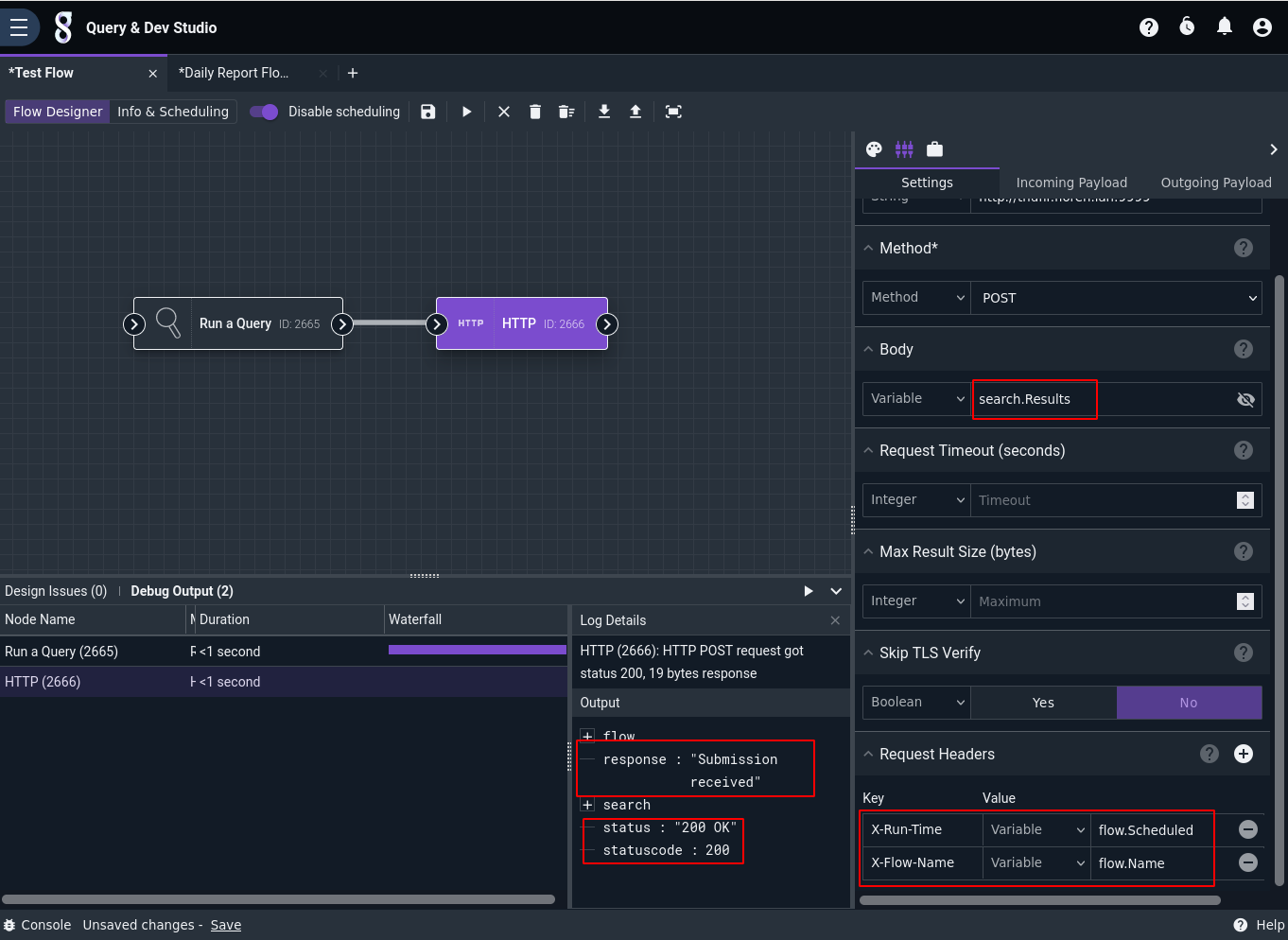HTTP Node#
This node can perform HTTP requests with considerable flexibility. It can send items from the payload in the body of the request, making it extremely useful for triggering infrastructure webhooks.
Configuration#
URL, required: The URL for the request. HTTP and HTTPS are both supported as well as referencing secrets.Method, required: The HTTP method to be used.Body: If set, the contents of the Body config option will be sent in the body of the HTTP request.Request Timeout: If set, the request will time out after this many seconds.Max Result Size: If set, the node will read no more than this many bytes in the HTTP response.Skip TLS Verify: If set to true, the node will not validate the TLS certificate of the HTTP server. Use with caution!Request Headers: May be used to set headers on the outgoing HTTP request, such as authentication tokens.Decode Body: If set to true, the node will attempt to decode the response body into a structure.
The contents of the Body are treated as follows:
Strings or byte slices are sent verbatim.
Results from a Gravwell Query will be processed based on the renderer used.
raw/text/hex: the body of the entries will be printed one per line.table: the results will be returned as a CSV.pcap: the results will be output in PCAP format.
All other types will be formatted to a string at best-effort using Go’s fmt library.
Output#
The HTTP node sets several items in the outgoing payload:
response: The body of the HTTP response, if any.status: A string representation of the HTTP status, e.g. “200 OK”.statuscode: The numeric HTTP response code, e.g. 200.
Example#
This example runs a Gravwell query (tag=gravwell limit 2) and sends the results to a simple HTTP server listening for POST requests.
The HTTP node is configured to use search.Results as the request body. Internally, it formats the search results as a string before sending. It is also set up to attach two headers to the request: X-Run-Time will contain the time at which the flow ran (the flow.Scheduled variable), and X-Flow-Name will contain the name of the flow (the flow.Name variable).
The screenshot below shows the results of a debug run:

The HTTP server logged the following:
Headers: map[Accept-Encoding:[gzip] User-Agent:[gravwell-5.0.0] X-Flow-Name:[Test Flow] X-Run-Time:[2022-03-15 23:27:17.966735258 +0000 UTC]]
Body: <15>1 2022-03-15T23:27:16.315639Z web1.floren.lan webserver 0 - [gw@1 host="192.168.10.1" method="DELETE" url="/api/scheduledsearches/1439300184/error" status="200" useragent="Mozilla/5.0 (X11; Linux x86_64; rv:98.0) Gecko/20100101 Firefox/98.0" elapsed="3ms"]
<15>1 2022-03-15T23:27:16.278106Z web1.floren.lan webserver 0 - [gw@1 host="192.168.10.1" method="GET" url="/api/scheduledsearches/checkin" status="200" useragent="Mozilla/5.0 (X11; Linux x86_64; rv:98.0) Gecko/20100101 Firefox/98.0" elapsed="0ms"]
Note the headers; the Accept-Encoding and User-Agent headers are automatically set by the search agent.
Example With Decode Body#
The HTTP node can return data of any type. By default, the node will store the response data as an array of bytes; when working with binary data or grabbing a remote file to use as a resource, this is the most useful form. Other use cases for the HTTP node may want to natively process an HTTP response so that the flow can more easily handle the response data; examples may include better display of text data or accessing fields in a JSON response.
This example performs an HTTP GET request on a remote API which returns JSON data using the HTTP node with Decode Body set to true; because the Decode Body value is set to true, the HTTP node will look at the Content-Type returned by the HTTP request and determine if it can decode the response into an object. Because the remote endpoint returns a JSON object, we can decode that into the payload as structured data which can then be processed in the flow. The decoded response payloads make it easy to take the response from one API and use it to create a request to another without having to manually decode the HTTP response.
